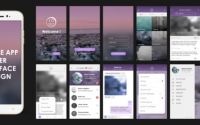Mobile App Testing Checklist For App Developers
Mobile App Testing Checklist For Developers
Mobile apps evolve into critical components of the business which make it predominant for the mobile app developers to ensure that their apps are of the finest quality. As per the studies, around 4.6 billion of the people are using the mobile devices. Thus, it is necessary to define the right testing criteria and follow proper tools to create and render high-quality biz mobile apps. Quality Assurance (QA) plays an important role in every step of the mobile app development ranging from concept creation, requirement analysis, test specifications, early versions of the app testing, finished product release to the post-development review process.
A necessary approach here is to be cautious enough for including every essential element in testing so that there will be no scope of any flaw.
Checklist To Follow In App Testing
Below listed points are necessary enough to put in every mobile app that you produce-
Functionality: Ensure that an app and all its features work well as defined;
Load Testing: Check the effects of multiple concurrent users over the back-end systems;
User Interface: Make sure that the users can perform their tasks in a clear and logical way;
Performance: Measure an app’s impact on CPU, network usage and memory, along with the time needed to complete certain functions;
Security: Guarantees that the data which an app builds, accesses and saves remains secured.
Now, you must be thinking about the elements that can complete your testing process.
Let’s read few essential aspects one should focus:
• App Customization
Being an app owner, you can get the maximum advantages when your mobile app utilizes the best of all the resources that an app should render. For instance, the design needs to be optimized for both the small and large screen devices.
Ideally, a big screen must not create pixelation of the graphics while small screen should not result in an image which is cut.
Apps, in general come with a customization feature to work within an optimized manner irrespective of the device. A tester must be aware of this feature to test an app for its efficient functioning.
• Automation Tools
The Automation tools and services of the mobile app make use of simulators and emulators. It simply recreates an app experience which is running on a specific device and operating system.
Thereafter, these tools provide reports and analytics to help developers so that they can identify and address issues related with the user experience and application code.
• User Feedback
If your mobile app is an updated version of an existing App Store or Google Play offering, it is better to analyze user reviews and feedback being posted on different social networks and app marketplace.
It is obvious that several issues will be identified and documented in these environments by the end users, and these details can help to a great extent for analyzing and focusing on the the major loopholes of an app.
With the new app versions, users expect to find specific problems and their solutions. If this does not happen, it creates negative impact, majorly in case more time has been encountered for documenting or reporting the errors.
Different App Testing For Distinct Platforms
There are different types of apps and operating systems available in the web market that need dedicated attention in the testing.
Here is the list :
1. Apple iOS testing
1. It must be in compliance with the Apple’s UI Guidelines.
2. It should be backward-compatible with the OS (a new version of the OS is expected to maintain full functionality of the app)
3. In multitasking, all the app’s settings and its current progress must be preserved in case an app is minimized or a user switches between apps.
4. In testing, there is no need to reboot the device.
2.Google’s Android testing
1. The app must support all the running apps in the background.
2. For debugging via USB, you need to select “Enable USB Debugging” from device settings. Then, the device can be connected to the PC.
3.When “Back” button is used, the app should only be minimized without closing. Else, you need to reboot the device to run the app again.
3. Windows Mobile testing
1. The app must support multiple apps running in the background
2. All the apps must be closed via task manager
3. To debug the app, you can connect a device to the computer via USB.
Sum Up
Mobile application testing becomes quintessential in the era of enterprise mobility where QA engineers are needed to put themselves into the shoes of the user. The successful development of an app allows to involve quality assurance in all stages of the mobile app development process. It is advisable to add the above-mentioned end-user concerns within the test checklist in a distinct category of problems. With this, they can be checked within special attention during the course of testing and give you frictionless results.


